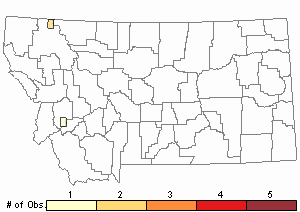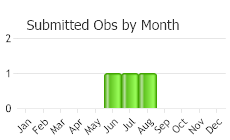View in other NatureServe Network Field Guides
NatureServe
Montana
Utah
Wyoming
Idaho
Wisconsin
British Columbia
South Carolina
Yukon
California
New York
A Bryum Moss - Imbribryum gemmiparum
Other Names:
Bryum gemmiparum
General Description
Plants: Acrocarpous (Vitt 1988). Growing in upright clumps, sometimes shiny, brilliant- to yellow-green, becoming straw-colored with time. Stems usually 1-2 cm tall (FNA 2014), occasionally forking below the apex (Lawton 1971), occasionally thickly covered with brown rhizoids when old (FNA 2014).
Leaves: Green, or occasionally yellow-tinged when young, soft and somewhat loosely arranged (FNA 2014), hardly contorted when dry, upright and spreading a little when hydrated (Crum & Anderson et al. 1981), 1-3 mm in length (FNA 2014), 0.5-0.7 mm in width (Lawton 1971), lance-shaped (Crum & Anderson et al. 1981) to egg-shaped and deeply cupped; margins smooth (FNA 2014), typically flat above (Lawton 1971), sometimes a little rolled back and downward below (mostly when dry) (Crum & Anderson et al. 1981), borderless; base extending down the stem only slightly (FNA 2014); leaf tip acute or somewhat obtuse (Lawton 1971); costa extending to or a little shy of the leaf tip, brown or sometimes tinged with yellow (FNA 2014).
Leaf Cells: Basal cell row uncolored, the transition to proximal laminal cells sudden; proximal cells short-quadrangular, the area occasionally sprinkled with square cells; upper and middle cells fine-walled, 6-sided (FNA 2014) to rhomboidal (Crum & Anderson et al. 1981) and elongated in line with the costa; margins of 1 cell layer (FNA 2014).
Phenology
Fruit ripens springtime to summertime (FNA 2014).
Range Comments
North American Range
AK, BC and AB, s to CA, AZ and NM, ND, SD, OK, MN, MI, MO, PA ne to ME (FNA 2014). Known in Montana from Flathead County (Elliott 2016).
Observations in Montana Natural Heritage Program Database
Number of Observations: 3
(Click on the following maps and charts to see full sized version)
Map Help and Descriptions
Relative Density

Recency


 (Observations spanning multiple months or years are excluded from time charts)
(Observations spanning multiple months or years are excluded from time charts)
Habitat
Calcareous soil or soil-covered rock in moist to wet conditions (FNA 2014), such as along stream banks, around springs, on seepage areas of bluffs (Crum & Anderson et al. 1981). Elevation: 0-5910 feet (FNA 2014).
Reproductive Characteristics
Dioicous. Sporophytes rare (FNA 2014). Seta 1-2 cm tall, russet (Lawton 1971). Capsule brown, pear-shaped, 2-3 mm in length, somewhat ascending to drooping; peristome double; cilia long and transversely ridged (FNA 2014).
Specialized vegetative reproduction by tubers growing on axillary rhizoids from the leaves, the tubers pinkish; seldom occurring. Although this form of reproduction has been observed for this species in Europe, it has not been verified in North American plants (FNA 2014).
Stewardship Responsibility
References
- Literature Cited AboveLegend:
 View Online Publication
View Online Publication Crum, H.A. and L.E. Anderson. 1981. Mosses of Eastern North America. 2 volumes. Columbia University Press, New York. 1328 pp.
Crum, H.A. and L.E. Anderson. 1981. Mosses of Eastern North America. 2 volumes. Columbia University Press, New York. 1328 pp. Elliott, J.C. and A.K. Pipp. 2018. A Checklist of Montana Mosses (1880-2018). Updated 3 January, 2020. Montana Natural Heritage Program, Helena, Montana. 73 pp.
Elliott, J.C. and A.K. Pipp. 2018. A Checklist of Montana Mosses (1880-2018). Updated 3 January, 2020. Montana Natural Heritage Program, Helena, Montana. 73 pp. Flora of North America Editorial Committee, eds. 2014. Flora of North America North of Mexico. Volume 28. Bryophytes: Mosses, Part 2. Oxford University Press, Inc., NY. xxi + 702 pp.
Flora of North America Editorial Committee, eds. 2014. Flora of North America North of Mexico. Volume 28. Bryophytes: Mosses, Part 2. Oxford University Press, Inc., NY. xxi + 702 pp. Lawton, E. 1971. Moss Flora of the Pacific Northwest. Hattori Botanical Laboratory. Japan: Yamabuki-cho, Shinjuku-ku, Tokyo. 362 pages plus appendices.
Lawton, E. 1971. Moss Flora of the Pacific Northwest. Hattori Botanical Laboratory. Japan: Yamabuki-cho, Shinjuku-ku, Tokyo. 362 pages plus appendices. Vitt, D. J. Marsh, and R. Bovey. 1988. Mosses, Lichens & Ferns of Northwest North America. Seattle, WA: University of Washington Press. 296 p.
Vitt, D. J. Marsh, and R. Bovey. 1988. Mosses, Lichens & Ferns of Northwest North America. Seattle, WA: University of Washington Press. 296 p.
- Additional ReferencesLegend:
 View Online Publication
View Online Publication
Do you know of a citation we're missing? Elliot, J. C. 1993. Second checklist of Montana mosses. Unpublished report. U.S. Forest Service, Region 1. Missoula, MT. 45 pp.
Elliot, J. C. 1993. Second checklist of Montana mosses. Unpublished report. U.S. Forest Service, Region 1. Missoula, MT. 45 pp. Flowers, S. 1973. Mosses: Utah and the West. Brigham Young University, Provo, Utah. 567 p.
Flowers, S. 1973. Mosses: Utah and the West. Brigham Young University, Provo, Utah. 567 p. Lawton, E. 1971. Keys for the Identification of the Mosses on the Pacific Northwest. Reprinted from 'Moss Flora of the Pacific Northwest'. Published as Supplement No. 2 of the Journal of the Hattori Botanical Laboratory. Nichinan, Miyazaki, Japan. 66 pp.
Lawton, E. 1971. Keys for the Identification of the Mosses on the Pacific Northwest. Reprinted from 'Moss Flora of the Pacific Northwest'. Published as Supplement No. 2 of the Journal of the Hattori Botanical Laboratory. Nichinan, Miyazaki, Japan. 66 pp. Malcolm, B., N. Malcolm, J. Shevock, and D. Norris. 2009. California Mosses. Nelson, New Zealand: Micro-Optics Press. 430 pp.
Malcolm, B., N. Malcolm, J. Shevock, and D. Norris. 2009. California Mosses. Nelson, New Zealand: Micro-Optics Press. 430 pp.
- Web Search Engines for Articles on "A Bryum Moss"





